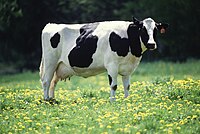
Photo from wikipedia
Environmental concerns with P of animal origin polluting surface waters are leading to legal incentives aimed at reducing the dietary P content of dairy cow rations to the lowest possible… Click to show full abstract
Environmental concerns with P of animal origin polluting surface waters are leading to legal incentives aimed at reducing the dietary P content of dairy cow rations to the lowest possible level that does not negatively affect health and productivity. The objective of the present study was to determine the effect of feeding rations with low dietary P content in late gestation on the Ca homeostasis of the periparturient dairy cow. Eighteen multiparous dairy cows were either fed a P-deficient (0.15% P in dry matter antepartum and 0.20% P in dry matter postpartum) but otherwise balanced ration or a control ration with adequate P content (0.28% P in dry matter antepartum and 0.44% P in dry matter postpartum) during the last 4 wk of gestation until d 10 postpartum. Blood was obtained before initiation of P-deprivation (baseline) and -10, -2, +1, +3, and +10 d relative to parturition to be analyzed for plasma concentrations of Ca [Ca] and inorganic phosphate [Pi]. In addition, plasma concentrations of parathyroid hormone [PTH], the bone resorption marker CrossLaps [CTX], 25-hydroxyvitamin D, and 1,25-dihydroxyvitamin D were determined in a subset of samples. Feeding a P-deficient diet for 4 wk antepartum positively affected the Ca homeostasis of periparturient cows. Clinical hypocalcemia occurred in 3/9 control and 0/9 P-deprived cows. [Calcium], [PTH], and plasma concentrations of vitamin D metabolites did not differ between groups until parturition, whereas [Pi] was decreased and [CTX] significantly increased in P-deprived animals. At parturition [PTH] was significantly greater in control cows compared with P-depleted cows. The P-deprived cows had significantly higher [Ca] than control cows on d +1 (2.46 ± 0.11 vs. 2.27 ± 0.41 mmol/L) and +2 (2.61 ± 0.13 vs. 2.35 ± 0.25 mmol/L). Plasma [CTX] was significantly higher in P-deprived than in control cows on d +2. Bone resorption and the typical increase in 1,25-dihydroxyvitamin D in periparturient P-deprived cows seemed to occur despite the smaller rise of [PTH], suggesting either greatly increased sensitivity to PTH or bone mobilization independent of PTH. Future studies must explore potentially negative effects of P-deprivation antepartum on health and productivity of the dairy cow in the following lactation.
Journal Title: Journal of dairy science
Year Published: 2018
Link to full text (if available)
Share on Social Media: Sign Up to like & get
recommendations!